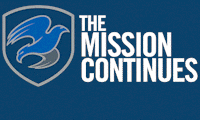A GENERATION OF VETERANS ANSWERED THE CALL
The ability and desire to adapt and overcome is part of a veteran’s DNA and the mission is urgent and clear: to combat food insecurity in under-resourced communities where we can leave a legacy of service.
If you’d like to partner with Operation Nourish, contact Tami Brown, Director of Corporate & Foundation Partnerships at tbrown@missioncontinues.org
WHY US – WHY NOW?
The communities in which we serve are being disproportionately impacted by the pandemic—most notably around issues of food insecurity. Lines of cars snaking for miles to pick up food from local pantries, food banks, schools, and otherwise have become commonplace. Since the beginning of the pandemic, rates of household food insecurity have doubled and the rates of childhood food insecurity have quadrupled.
A national survey in April 2020 found that more than 17 percent of mothers reported that their children under the age of 12 weren’t getting enough to eat because the family couldn’t afford enough food —a more than 400 percent increase from when the government last measured hunger rates in 2018.
In San Antonio, Texas, 10,000 people waited for hours to receive meal boxes from a regional food bank in April 2020. In Pittsburgh, Pennsylvania, hundreds of families have been showing up for weekly food pickups at the PPG Paints Arena. And in Sunrise, Florida, cars stretched for nearly two miles, while people waited at a Feeding South Florida food bank site.
And food insecurity affects veterans as well: A study by Cambridge University conducted in 2015 found that about 27% of veterans that had served in Iraq or Afghanistan wars were food insecure and a 2018 study showed more than 1.5 million veterans live in a household that completely relies on SNAP to supplement their food intake.
By any metric, this is a crisis.
We’ve seen incredible support in our platoons across the country over the last few months, who have continued to meet the need in their communities—but we need even more support to continue our work. With more than 50 community partners in our existing network focused on food insecurity in under-resourced communities, we are uniquely positioned to tackle this issue head on.
And of course, the boots-on-the-ground efforts in combating food insecurity are another way we’ll support that. This work is building on work that our platoons are already doing around food insecurity, some for years already, and some who have pivoted in response to the current crisis. We plan to align our response to three pillars—distributing food, increasing food support capacity, and growing food—but as always, local platoons are encouraged to create opportunities that address the unique needs of their local communities.
Here are some examples of how platoons can take action in their community:
- Fostering seedlings for replanting in school gardens
- Veteran-driven community food drives
- Harvesting food from gardens to deliver to community partners
- Delivering food to homebound seniors or hard-to-reach populations
- Building, maintaining, and renovating food pantries
- Increasing food pantry capacity through projects like the Mobile Market Unit
- Growing food in community gardens and delivering to populations in need
Support the Mission
Make a Donation
If you are unable to volunteer, but want to support those who do, click below to make a donation amount of your choice.
Follow Us on Social
We are always updating our community about new opportunities with our leadership programs and service projects. Follow us on Facebook, as well as on Instagram, LinkedIn, Twitter, YouTube, and Tik Tok.
Find More Ways to Volunteer
We continue our mission all year round with various types of service projects, impacting our communities and the veterans who continue to serve. Check out our main volunteer page for a variety of projects.
 You are successfully logged in.
You are successfully logged in.





